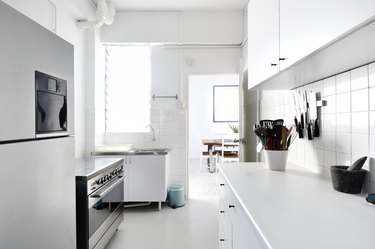
When rust settles on the surface of an otherwise well-working refrigerator, it can be unsightly and unsafe in the long run. Rust tends to grow when not attended to and can take down the solid structure of the refrigerator.
Rust can be removed from almost any surface with the right tools and techniques for that specific material. With good maintenance habits and proper handling, removing rust and keeping the fridge rust-free is a relatively simple endeavor. You can paint over rust with a coat of roll-on primer or simply sand down the spots to stop them from spreading.
Video of the Day
Video of the Day
Rust On a Fridge
It seems like a hardy appliance, but the refrigerator can need some gentle TLC to keep it in good working order. Most spots of rust on the fridge are typically caused by user neglect or vigorous cleaning with products not meant to come in contact with the fridge's enamel, stainless-steel or hard plastic surface.
There are a few reasons that rust collects on the surface of the refrigerator. Metal bolts, hinges and other hardware can become oxidized when exposed to water from vigorous cleaning efforts. The inevitable chips and dings on the exterior of a refrigerator in an active kitchen can also expose the metal beneath the enamel or other protective coating.
Rust on Stainless Steel
Stainless steel is a popular choice for refrigerators because it's a durable and stylish finish. But even a smooth and gleaming stainless-steel finish can be prone to tiny streaks of rust or pocks of red-tinged spots. Consumer Reports notes that using the wrong type of cleaning products can wear down the chromium in the stainless-steel material that prevents moisture from finding its way to the underlying steel layer. Using straight bleach can cause stainless steel to become corroded.
Make a paste of baking soda and lemon juice and apply this to rust spots on the stainless-steel surface. Use a small, soft toothbrush to scrub the paste into the rust spots and allow it to sit for 15 to 30 minutes.
Wash the refrigerator's exterior surfaces and the sides and tops of both doors with a solution of mild soap and water. Use soft cloths rather than abrasive sponges. A slathering of olive oil or mineral oil over the surface of the treated stainless steel can return it to its former luster.
Painting a Rusty Fridge
A vintage appliance with a few spots of rust can be charming and add a sense of authenticity to a farmhouse or shabby chic décor style. Painting over spots of rust can add to the aesthetic of a vintage appliance. However, Bob Vila recommends that the rusted area be sanded down to remove loose rust so that the primer and top paint coat will adhere to the area.
Use a piece of 80-grit sandpaper or wire brush to remove loose rust and smooth the area. Fill any pits in the surface with an auto body filler, such as Bondo, to shore up weak spots in the metal of the refrigerator's exterior. A good primer will create a smooth finish and help the paint to adhere to the rusted area of the appliance.